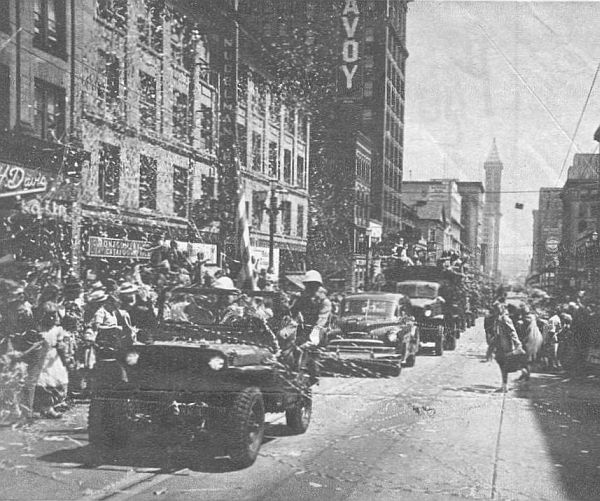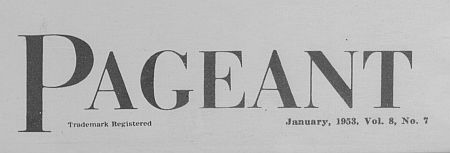
JackGordon.org

When the returning veterans hit Seattle, as half of them do, the whole town turns out to greet them so they will never forget
The long convoy of Army trucks and buses, bound for nearby Fort Lawton, moves slowly through a canyon of office buildings in the heart of downtown Seattle. Cheering people overflow the sidewalks and press into the street to see the glad faces of the homeward bound troops, who just stepped off a Navy transport from Korea. A spirit of carnival fills the air.
An attractive, young stenographer from a nearby bank pushes through the crowd carrying an armful of roses. She thrusts them into the soldiers' outstretched hands. This is Welcome Lane, U.S.A., a block long Seattle street, set up in any one of three locations on Second and Fourth Avenues to provide a hero's ovation for veterans of the Korea fighting.
To appreciate Welcome Lane, you ought to see it, feel it. Miles of gaily colored serpentine wind around the buses and trucks and a sea of confetti falls lazily on all sides. People hand out flowers and toss apples and candy kisses. Soldiers reach out to touch the hands of the people, and the people reach for the soldiers as they crowd toward the trucks and buses. And all the time the band is playing "There'll Be A Hot Time in the Old Town Tonight."
Up to now more than 125,000 servicemen from the United States, Canada, Puerto Rico, and even South Korea, have ridden through 80 Welcome Lanes since the spring of 1951. They have all felt the exuberance and warm elation of a returning hero cheered and appreciated by a grateful people. As one young corporal put it after riding through the "Lane": "I felt bigger than' General MacArthur."
That's just the feeling the people of Seattle want to convey. As the place where some half of the Korea veterans returning on rotation first set foot on American soil, Seattle has undertaken the welcoming job for the whole United States. It is a unique network of community effort under the sponsorship of Greater Seattle, lnc. (a non-profit civic booster group), working in conjunction with King County U.S.O., a local musicians' union and a host of volunteers.
Just what is there to Welcome Lane which makes it so effective? Physically speaking Welcome Lane consists only of a flatbed truck, a small pick up band with vocalist (financed from recording royalties from the Music Performance Trust Fund, New York City), a few boxes of serpentine, a master of ceremonies, a sound truck and a pile of flowers.
The main spark of life in Welcome Lane is Jack Gordon, Chairman of the Korea Veterans Reception Committee, and also the man behind the microphone on the flatbed truck. He directs the pierside show while the troops are still aboard ship, then collects his entertainers and races to Welcome Lane before the troops arrive to warm up the crowd. (Jack figures it takes at least a half-hour to turn a lot of individual people into a unified, cheering crowd.)
Welcome Lane doesn't just happen; it results from a lot of people working together. "I think we've got the largest volunteer committee in the world," boasts Jack Gordon.
One such volunteer is Mrs. Gudron Baker who works in a bank bordering Welcome Lane. During the first Welcome Lane reception she suddenly snatched a bunch of flowers from her desk, raced out into the street and tossed them to the passing soldiers. The soldiers liked it. Soon the idea caught on, and scores of girls along financial row began bringing flowers to work for use in Welcome Lane. To help in the flower supply Seattle wholesale florists offered donations if someone would make the pick-ups.
Mike Cummings, a taxicab driver with a son in Korea, volunteered to do the job. Mike makes the rounds collecting flowers which he turns over to Mrs. Baker, who now heads a task force of "flower girls."
Another star volunteer is Chet Gibson who provides a sound truck for Welcome Lane free of charge. He hasn't missed a show yet. Dancers from the Barclay Studios occasionally add to the entertainment.
But probably the most significant volunteers are the perennial visitors to Welcome Lane—the ones who come time after time to fill the spaces in the street and provide the human element which is the heart of the ceremony. Of course, along with the volunteer workers are the official agencies which combine efforts to stage Welcome Lane. Among them are the Police Department, the City Engineer, Fort Lawton, Seattle Port of Embarkation, Greater Seattle, Inc., and the Musicians Association, Local 76, A. F. of M.
Naturally Welcome Lane costs money, but Walter VanCamp, managing director of Greater Seattle, Inc., figures the amount of money spent is well worth it, considering the good it is doing both for the returning servicemen and in establishing Seattle as the welcome city of the nation. So far Greater Seattle has expended some $15,000 for more than 38 million feet of serpentine, salaries and miscellaneous expenses. In addition about $9,000 has come from the Music Performance Trust Fund for Welcome Lane music.
Jack Gordon has often wondered just how the boys felt about Welcome Lane after they'd been through it, but never had an opportunity to talk with any of them—not until one morning not long ago when he was warming up the crowd for the second Welcome Lane in two days. A young Negro soldier called to him and asked if he could stand on the truck. Jack said sure.
In the conversation which followed Jack learned he went through Welcome Lane the day before.
"It was great," the soldier explained, "but it all happened so fast that I wanted to see it over again, from beginning to end. This welcome is all the fellows talked about while they were processing at Fort Lawton. It sure was swell."
The question still comes up now and then of how long this Welcome Lane will keep going.
Old Charley Lombard, the self-appointed rooter, who's taken part so often he helps direct traffic, puts it this way: "Stop Welcome Lane? Not on your life. Not until every one of those boys who's been fighting for us in Korea is home again." • •

You are at JackGordon.org,
a salute to John F "Jack" Gordon, Mr. Seattle